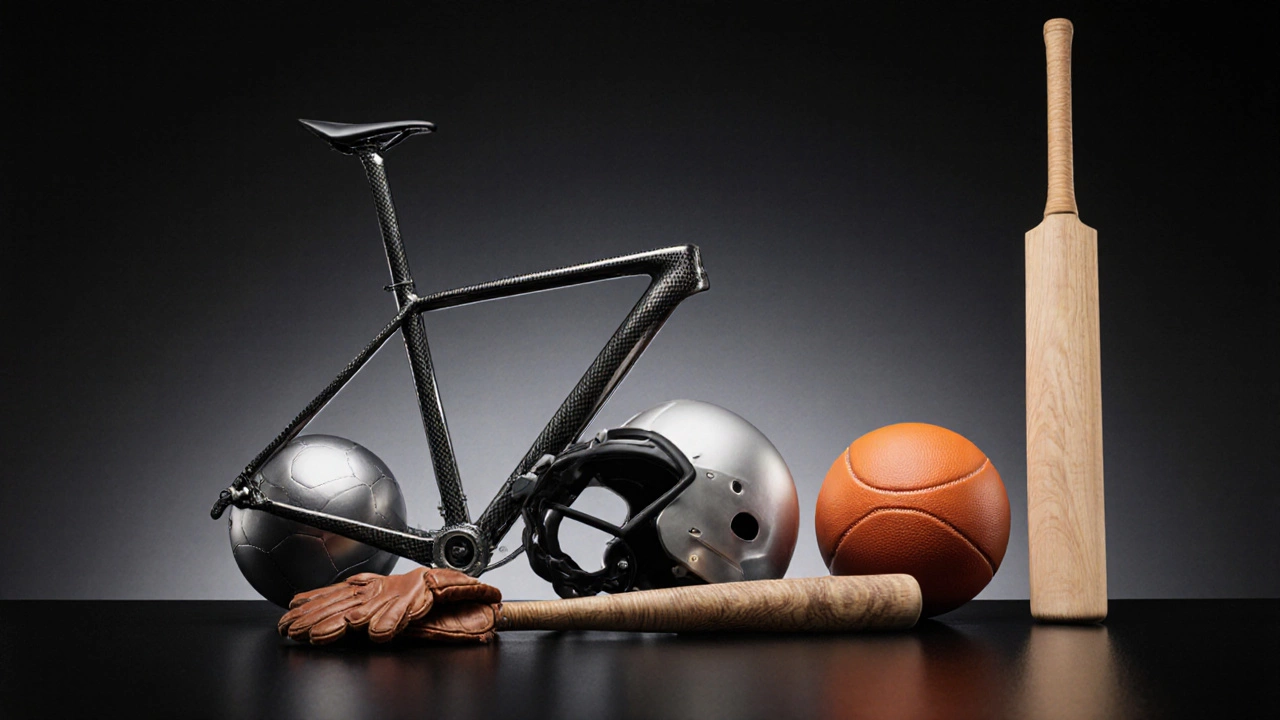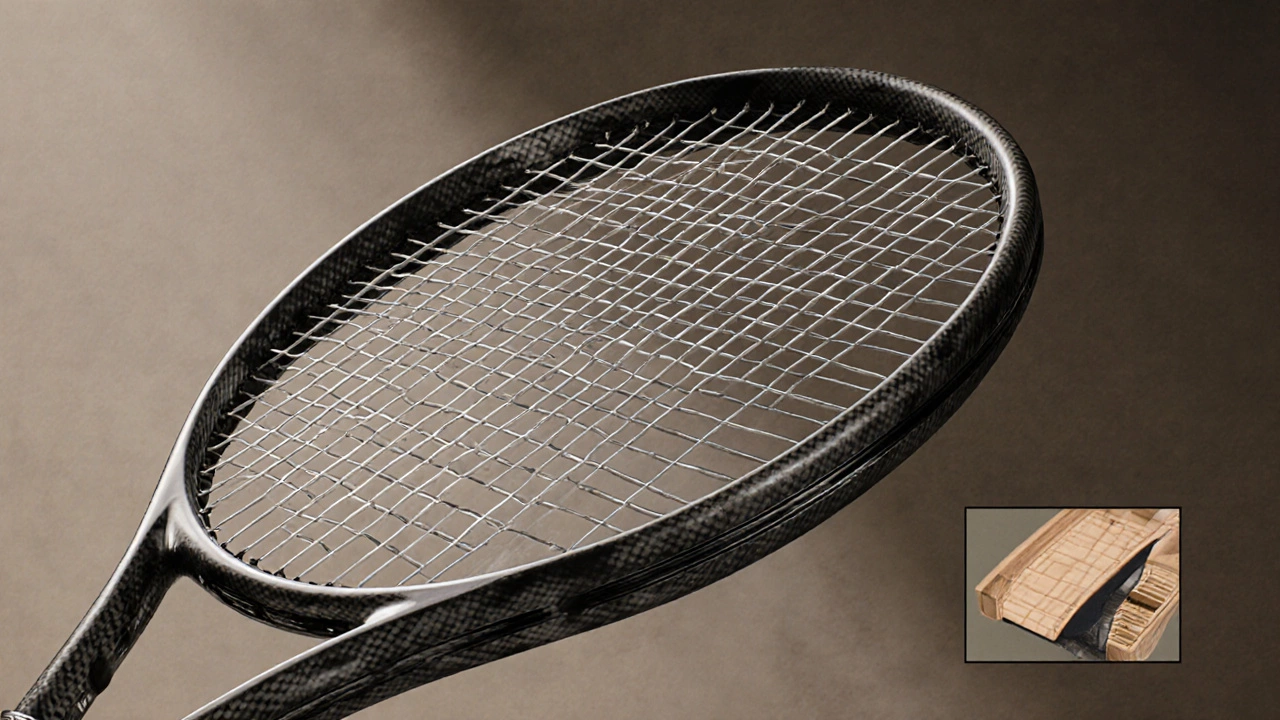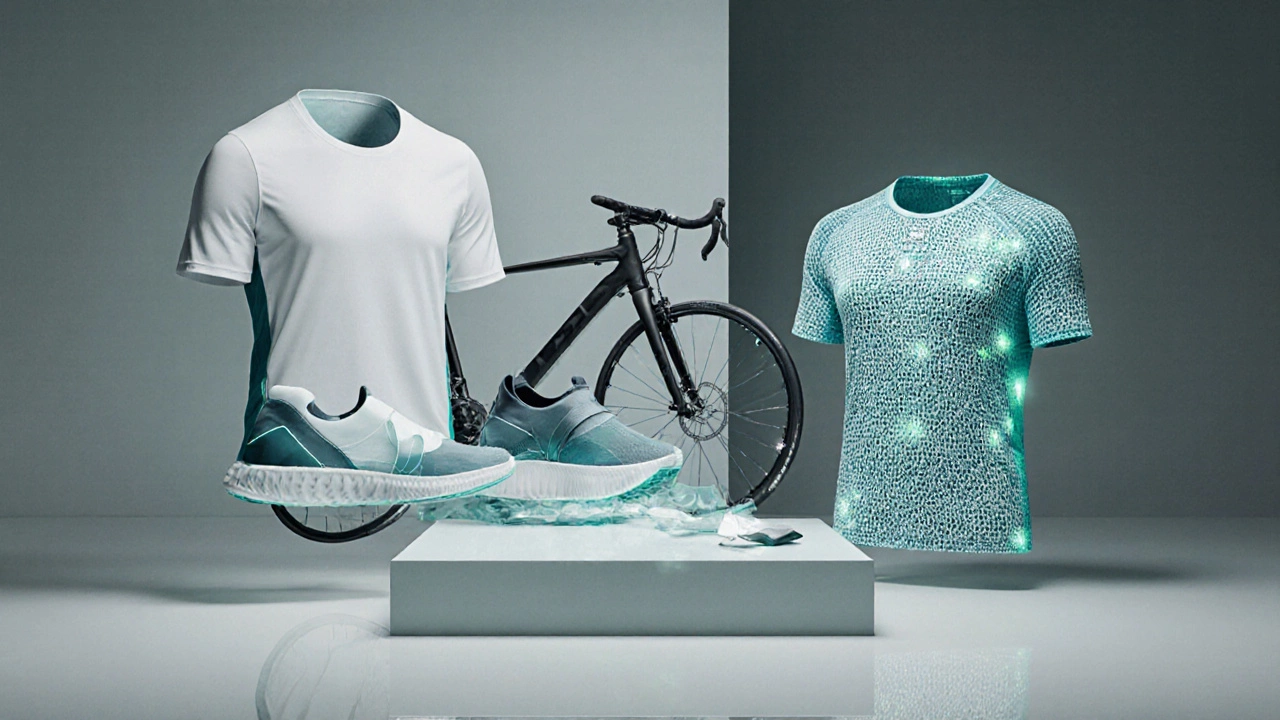
Sports Equipment Material Selector
Select your sport and priority, then click "Find Best Materials" to get personalized recommendations.
Popular Materials Explained
Carbon Fiber
Ultra-lightweight, high-strength. Used in high-end bikes and rackets.
Aluminum
Balanced weight and durability. Common in bats and bike frames.
Polycarbonate
Impact-resistant plastic. Used in helmets and protective gear.
When you pick up a tennis racket, lace up a pair of cleats, or strap on a helmet, you’re trusting a mix of science, tradition, and engineering. Knowing sports equipment materials helps you pick gear that feels right, lasts longer, and fits your budget.
Sports equipment is a category of tools and gear used to play, train, or compete in various sports. From a simple rubber ball to a high‑tech carbon‑fiber bike frame, each item’s composition shapes its performance, safety, and environmental footprint.
Why Material Choice Matters
- Performance - Weight, stiffness, and flexibility affect how fast, accurate, or powerful you can be.
- Safety - Some materials absorb impact better, protecting athletes from injury.
- Durability - The right blend can survive rough weather, repeated hits, and years of use.
- Cost - Exotic composites cost more, while classic woods stay affordable.
- Sustainability - Eco‑friendly choices reduce waste and carbon emissions.
Common Materials and Their Traits
The sports world leans on a handful of materials that balance cost, strength, and weight.
| Material | Typical Uses | Weight | Durability | Cost | Environmental Impact |
|---|---|---|---|---|---|
| Carbon fiber | Bike frames, tennis rackets, golf club shafts | Very light | High | High | Energy‑intensive production, recyclable in advanced facilities |
| Aluminum | Baseball bats, bike frames, hockey sticks | Light‑moderate | Moderate‑high | Moderate | Highly recyclable, low‑to‑moderate extraction impact |
| Steel | Golf club heads, weight plates, football helmets (inner shells) | Heavy | Very high | Low‑moderate | Widely recycled, high mining impact |
| Leather | Football gloves, baseball mitts, boxing bags | Moderate | High (if well‑treated) | Moderate‑high | Biodegradable, but raises animal‑welfare concerns |
| Synthetic leather (PU, PVC) | Basketball shoes, training gloves, some soccer balls | Light‑moderate | Good | Low‑moderate | Petroleum‑based, not biodegradable |
| Rubber | Soccer balls, basketballs, grip on handles | Moderate | High (resists wear) | Low‑moderate | Natural rubber is renewable, synthetic rubber is petro‑derived |
| Polyurethane (PU) | Foam padding, shoe midsoles, skateboard wheels | Very light | Good (flexible) | Low‑moderate | Petroleum‑based, some bio‑PU options emerging |
| Wood | Baseball bats, cricket bats, traditional ski cores | Moderate‑heavy | Varies (hardwoods > softwoods) | Low‑moderate | Renewable, carbon‑sequestering when sourced responsibly |

Material Deep‑Dive by Sport
Let’s look at how the top‑used materials show up in specific gear.
Ball Sports
- Soccer balls - Outer panels are typically synthetic leather (PU), stitched over a butyl bladder for air retention.
- Basketballs - Full‑grain leather for professional leagues; community courts use composite leather (synthetic).
- Tennis balls - Felt tops made from nylon and polyester, with a rubber core.
Racket Sports
- Tennis rackets - Frames built from graphite (a carbon fiber blend) for stiffness, with fiberglass or titanium inserts in premium models.
- Badminton rackets - Mostly carbon fiber, sometimes mixed with aluminum for a softer feel.
Protective Gear
- Football helmets - Outer shell of polycarbonate (a tough plastic) and inner padding of expanded polypropylene (EPP) foam, which disperses impact energy.
- Cycling helmets - Similar polycarbonate shells paired with EPS foam liner.
- Boxing gloves - Outer layer of genuine leather or high‑grade synthetic leather, with inner foam padding (usually PU).
Racing and Cycling
- Bike frames - Entry‑level models use aluminum; mid‑range use carbon fiber for weight savings; high‑end frames may blend titanium for comfort.
- Shoes - Upper often synthetic leather or mesh; midsoles use EVA or PU for cushioning; outsoles are rubber compounds tuned for grip.
Choosing the Right Gear: A Simple Checklist
- Identify the main activity (e.g., running, soccer, climbing).
- Prioritize what matters most: weight, durability, cost, or eco‑friendliness.
- Match material to priority:
- Need ultra‑light? Look for carbon fiber or high‑grade aluminum.
- Budget‑friendly? Steel, wood, or basic synthetic leather work well.
- Eco‑conscious? Natural rubber, responsibly sourced wood, or recycled aluminum.
- Check manufacturer claims - verify certifications like ISO 14001 (environment) or ASTM standards for impact resistance.
- Take a demo if possible. Feel the grip, test the bounce, or swing the bat before buying.

Emerging Trends in Sports Materials
Manufacturers aren’t standing still. Here are three hot developments you’ll see more of in the next few years:
- Bio‑based polymers - Made from plant oils or algae; they aim to replace petroleum‑based PU in foam padding.
- Recycled composites - Carbon fiber reclaimed from aerospace waste is being blended into bike frames, cutting cost and carbon intensity.
- Smart textiles - Fibers embedded with sensors (e.g., conductive nylon) that track heart rate or impact forces, often wrapped in a flexible polymer coating.
Common Pitfalls and How to Avoid Them
- Buying the cheapest plastic gear that cracks early - check for UV‑stabilizers in the polymer.
- Ignoring break‑in periods - leather shoes and gloves improve with use; skimping on proper break‑in can cause discomfort.
- Overlooking maintenance - rubber balls lose bounce when stored in heat; keep them in a cool, dry place.
- Assuming “all carbon fiber is the same” - weave pattern and resin type drastically affect stiffness.
Frequently Asked Questions
What material makes a basketball bounce best?
Professional basketballs use a full‑grain leather bladder surrounded by an inner butyl rubber layer. The rubber retains air pressure, while the leather provides a consistent surface that reacts predictably under pressure.
Are carbon‑fiber rackets worth the price?
If you play competitively and value a lightweight, stiff frame that transfers energy efficiently, carbon fiber can improve swing speed and control. For casual players, a graphite‑blend racket offers similar feel at a lower cost.
How can I make my sports shoes more sustainable?
Choose shoes with recycled rubber soles, bio‑based foam midsoles, and uppers made from recycled polyester or natural materials like hemp. Some brands also offer take‑back programs to recycle old pairs.
What’s the best material for a durable soccer cleat?
A synthetic leather (PU) upper with a reinforced toe and a rubber outsole that incorporates a carbon rubber compound provides durability, water resistance, and good ball control.
Can I replace the foam in my helmet with a greener option?
Some manufacturers now offer helmets with EPS foam blended with bio‑based polymers. Look for certifications that state “bio‑based content” or “recycled foam”.